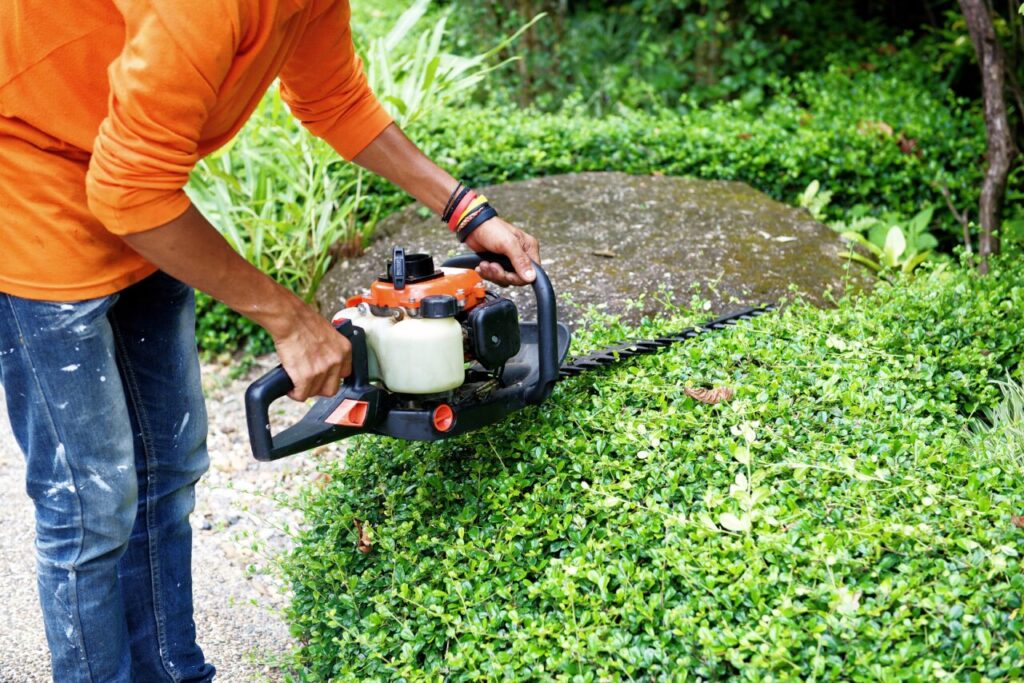Spring is a time of renewal, and that also extends to your lawn. After a long, cold winter, your yard is bound to need some upkeep if you want it to look its best.
Nearly 20% of homeowners say yard work is more expensive than they initially expected, which is all the more reason to stay diligent when it comes to consistent upkeep. Regular maintenance will reduce the likelihood of costly projects down the line, help maintain excellent curb appeal, and get potential buyers interested if you’re thinking about selling your home.
Follow the spring lawn maintenance checklist below to help ensure your lawn is healthy, lush, and green throughout the growing season.
1. Remove Debris
The first step in spring lawn maintenance is to clear away any buildup of debris that could have accumulated during the winter season. This includes fallen leaves, sticks, and other pieces that can smother grass and promote disease. Raking and bagging this debris is a great way to get rid of it and help your lawn get off to a good start.
2. Pressure Wash Driveway, Porches, and Sidewalks
Pressure washing can significantly improve the look of your yard by removing built-up dirt, grime, and stains. Over time, outdoor surfaces become discolored and unsightly, but pressure washing can quickly and effectively restore them to their original condition. And by taking good care of these areas, you help extend their lifespans.
3. Aerate Your Lawn
Frequent lawn use has a punishing effect on your grass, adding pressure and making it harder for necessary nutrients to reach roots. Aerating your lawn involves punching small holes into the soil to allow water, air, and nutrients to infiltrate more deeply into the root zone. This can help relieve compacted earth and improve drainage, leading to healthier grass. There are two options for getting the job done: You can either rent an aerator or enlist the services of a professional.
4. Overseed Bare Spots
If your lawn looks thin or patchy, overseeding can help fill in the gaps. This involves spreading grass seed over your existing lawn to encourage new growth. Make sure to choose a seed mix appropriate for your climate and soil type and follow the manufacturer’s instructions for application.
5. Apply Fertilizer
To help your lawn grow lush and weed-free, consider applying fertilizer to your lawn in the spring. Experts suggest watering your lawn both before and after you spread the fertilizer to help the nutrients penetrate the soil. There are a variety of fertilizers to choose from, so do some research ahead of time to figure out which is the best fit for your local grass and soil.
6. Weed Control
Targeting weeds in the springtime is an excellent opportunity to prevent them from taking over your lawn. Some homeowners prefer to remove weeds by hand, while others use herbicides. Be sure to wear gloves and pull the weeds out by the root to prevent them from growing back. Tackling unwanted weeds during the spring months will help ensure that your summer lawn is in tip-top shape.
7. Clean Your Gutters
Over the winter, debris such as twigs, leaves, and dirt can collect in your gutters, preventing water from flowing freely and potentially causing damage to your roof or foundation.
To clean your gutters, use a ladder and scoop out the debris by hand or with a scoop tool. After removing the debris, flush the gutters with a hose to make sure they are unobstructed and flowing correctly. Don’t forget to wear gloves and take safety precautions to avoid falls or injury.
8. Dethatch Your Lawn
If your lawn looks sparse or uneven, it may be time to dethatch. Dethatching involves removing the thick layer of thatch, which is a mat-like layer of dead turf and various organic matter that builds up on the soil’s surface. In many cases, this layer can prevent water and nutrients from reaching the roots of your grass. Dethatching the lawn can improve the chances of your grass getting the resources it needs to thrive.
9. Plant Summer-Flowering Bulbs
Spring is the ideal time to plant summer-flowering bulbs — such as gladiolus, dahlias, and lilies — since the ground has thawed and temperatures are warming up.
Be sure to space out the bulbs according to the guidelines for the specific bulb type. With proper planting and care, your summer bulbs will bloom beautifully in the warm summer months.
10. Monitor for Pests and Disease
Monitoring for pests and diseases is integral to spring lawn maintenance. Look for signs of damage, such as brown spots or yellowing, and take action as needed. You may need to apply an insecticide or fungicide to control the problem, or you may need to adjust your watering or fertilizing practices.
11. Don’t Forget to Edge
Edging your lawn gives it a neat, polished look. Use a spade or edging tool to create a clean line between your lawn and any adjacent hardscaping, such as sidewalks or driveways. Making these barriers also stops your grass from spreading into unwanted areas.
12. Watering the Right Way
Watering your lawn is essential to keeping it healthy and green, but it’s important to do it correctly. Make sure to water deeply and infrequently to encourage deep root growth. But be mindful of how much water you’re using.
Not only can overwatering lead to disease and root rot for your plants, but it’s also not great for the environment. If you want to reduce your daily water usage, consider investing in a water meter to monitor your daily output.
How to Save on Lawn Care Expenses
4 Ways to Budget for Home Maintenance Costs
How to Cut Costs on Lawn Care This Summer


